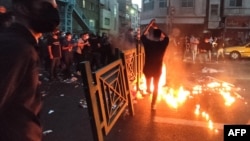Iranian President Ebrahim Raisi insisted Saturday that the government react firmly to the widespread protests across the country over the death of a young Kurdish woman, Mahsa Amini, at the hands of the regime's morality police.
In the week since her death, demonstrations have spread to at least 133 cities and left 41 protesters dead, state TV suggested Saturday.
Video on social media showed protesters torching a statue of Supreme Leader Ayatollah Ali Khamenei in his hometown of Mashhad on Friday, as they chanted slogans against him and the government. Other videos showed protesters in multiple cities, including the capital, Tehran, setting fire to Khamenei's portrait.
Raisi, who returned several days ago from a trip to the United Nations in New York, was reported by Iranian media to have told the family of a regime supporter killed in the protests that "the government must react decisively against the protests."
Raisi "stressed the necessity to distinguish between protest and disturbing public order and security, and called the events ... a riot," state media reported.
The protests are the largest since 2019, when Iranians took to the streets over fuel prices. At least 1,500 people were killed in the ensuing crackdown.
General Azizollah Maleki, the police chief of Gilan province, a hotbed of the current protests, told government media that security forces in his province are "on the verge of collapse." More than 700 people reportedly were arrested for protesting in Gilan.
Protesters reportedly took control of large parts of the mostly Kurdish town of Aznaveh in the northwest of the country after security forces were overwhelmed by the number of protesters.
Video on social media also showed violent clashes between protesters and government security forces and the volunteer pro-government Basij militia group in the district of Sattar Khan in Tehran.
Iran analyst Ali Nourizadeh told VOA that "women have joined their husbands, sons and brothers to protest in the streets," while students also have joined the protests in large numbers "despite the heavy-handed regime crackdown on student protesters during demonstrations last year and in 2018."
Nourizadeh said that, unlike the protests of 2009, 2018 and last year, there is "no single demand being made by protesters," other than the downfall of Khamenei and his regime.
"This time, nobody says anything about the economic situation,” he said. “We don't have any single slogans. They say death to Khamenei, [and] the regime should be toppled. They call [out to] Khamenei's son [Mojtaba, reputed to be in line to succeed his father], 'you will die, but you will not see the leadership.'"
Nourizadeh said he suspects that recent reports about Khamenei being in bad health "may have added to the anger of the people," who don't want Khamenei's son Mojtaba to succeed him.
Anti-government media is claiming that several thousand protesters have been arrested since the death of Amini last week ignited protests, initially in mostly Kurdish regions of the country.
Iranian journalist Aida Ghajar posted video on Twitter on Saturday of family members in front of Tehran's notorious Evin Prison, looking to find out if missing loved ones are being held there.
Some information for this report came from Reuters.

